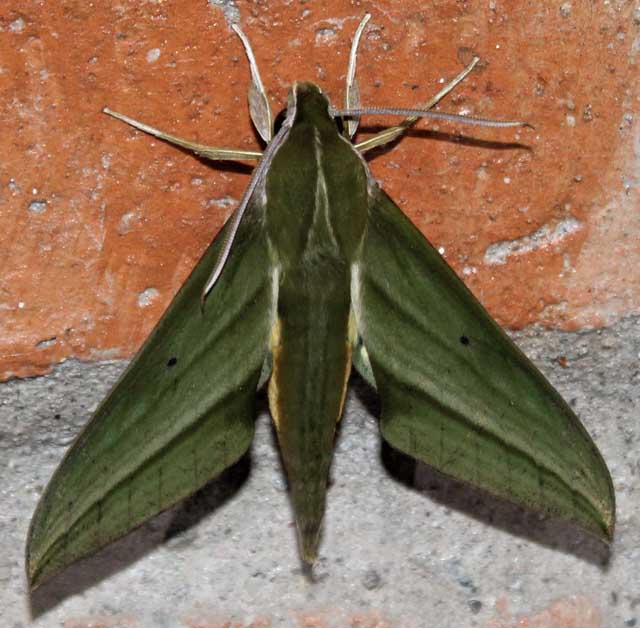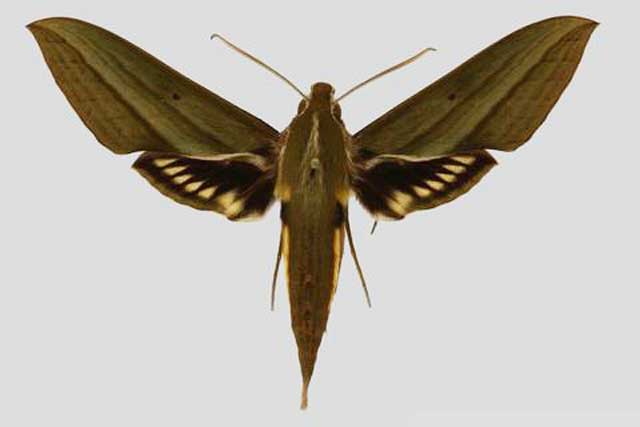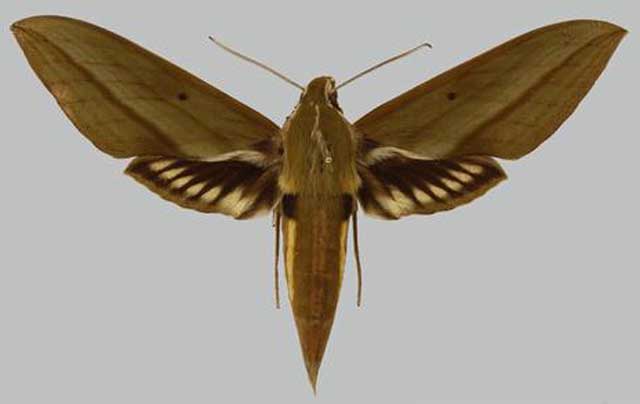Xylophanes huloti
|
|
Updated as per http://sphingidae.myspecies.info/taxonomy/term/5698; March 16, 2017
Updated as per personal communication with Shalyn Warrington, (Cuenca, Azuay, Ecuador, December 25, 2021); March 5, 2022
|
Xylophanes huloti
zail-AH-fan-eesM
HUE-lot-eye
Haxaire, 2003

Xylophanes huloti, Cuenca, Azuay, Ecuador,
December 25, 2021, 3,400m, courtesy of Shalyn Warrington, id by Jean Haxaire.

Xylophanes huloti male, Morona Santiago, Ecuador,
courtesy of Jean Haxaire as per Creative Commons,
Updated as per http://sphingidae.myspecies.info/taxonomy/term/5698
This site has been created by
Bill Oehlke. Comments, suggestions and/or additional information are welcomed by Bill.
TAXONOMY:
Family: Sphingidae, Latreille, 1802
Subfamily: Macroglossinae, Harris, 1839
Tribe: Macroglossini, Harris, 1839
Genus: Xylophanes Hubner [1819] ...........
Species: beneluzi Haxaire & Vaglia, 2008
|
DISTRIBUTION:
Xylophanes huloti
[wingspan 75mm] flies in
Ecuador: Morona Santiago Rte. Gualaceo-Limon PK.53.; Napo: Rte Cosanga to Tena; and Cuenca, Azuay;
Colombia.
This species is very close to the allied species, Xylophanes rhodochlora (Rothschild et Jordan, 1903).
FLIGHT TIMES:
Xylophanes huloti adults probably have at least two flights annually. Shalyn Warrington reports a late December flight in
Cueca, Azuay, Ecuador. I was surprised to see this specimen from the western side of the Andes and at such high elevation (3400m) as Jean Haxaire has described it from the eastern side
of the Andes in Moraona-Santiago and Napo.
ECLOSION:
Pupae probably wiggle to surface from subterranean chambers or leaf litter just prior to eclosion.

Xylophanes huloti male, Napo, Ecuador,
courtesy of Jean Haxaire as per Creative Commons,
Updated as per http://sphingidae.myspecies.info/taxonomy/term/5698
SCENTING AND MATING:Females call in the males with a pheromone released from a gland at the tip of the abdomen.
EGGS, LARVAE, PUPAE:
The pronunciation of scientific names is troublesome for many. The "suggestion" at the top of the page is merely a suggestion. It is based on
commonly accepted English pronunciation of Greek names and/or some fairly well accepted "rules" for latinized scientific names.
The suggested pronunciations, on this page and on other pages, are primarily put forward to assist those who hear with internal ears as they read.
There are many collectors from different countries whose intonations and accents would be different.
Jean Marie Cadiou writes, "When I say "Xylophanes" in English I pronounce it something like "Zailophanees", with the emphasis on the
"o". The French pronounce it differently, something like "Kzeelophaness" with no emphasis, and the Germans yet in a different way..."
In Greek myth, Phanes is the golden winged Primordial Being who was hatched from the shining Cosmic Egg that was the source of the
universe. He personifies light emerging from chaos.
"Xylo" is the Greek word for wood.
The specimen type for the genus Xylophanes is Xylophanes anubus. Perhaps ? when Hubner
examined that species, the yellow-orange and brown tones of the forewings suggested wings of wood.
The species name "huloti" is honourific for a man named Nicolas Hulot.
Use your browser "Back" button to return to the previous page.
Goto Main Sphingidae Index
Goto Macroglossini Tribe
Goto Central American Indices
Goto Carribean Islands
Goto South American Indices
Goto U.S.A. tables


